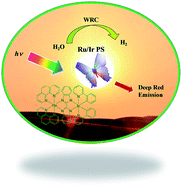Binuclear Ru–Ru and Ir–Ru complexes for deep red emission and photocatalytic water reduction†
Abstract
Four butterfly-like binuclear Ru(II)–Ru(II) and Ir(III)–Ru(II) complexes were designed and synthesized via a stepwise method by Ru(II)/Ir(III) metalloligands containing polypyridine (bpy)/phenylpyridine (ppy), phenanthroline (phen) and bibenzimidazole (BiBzIm) moieties. The absorption and photoluminescence of Ru(II)–Ru(II) compounds are dominated by metal-to-ligand charge-transfer (MLCT) transitions from Ru(II) centers to the organic ligand parts, which emit in the deep red region with a wavelength ∼700 nm. While in Ir(III)–Ru(II) complexes, an additional decay channel is opened for the energy transfer from the higher energy level MLCT state of Ir(III)-coordinated units to the lower-energy level MLCT state of Ru(II)-coordinated units, as approved by both experimental and theoretical DFT calculations. Therefore, similar deep red emission profiles originating from Ru(II) units are observed in Ir(III)–Ru(II) systems. These binuclear complexes were further tested as photosensitizers (PSs) to produce H2 in photocatalytic water reduction systems. The highest H2 production efficiency can be obtained in the heteronuclear IrRu(1) system after 80 hours continuous production with a TON value of 1088 based on the amount of IrRu(1) as PS, much higher than the other binunclear complexes and mononuclear counterparts. The results provide a new insight into the designing guidelines for noble metal complexes as emitting centers and photosensitizers in lighting/display materials and devices, as well as photocatalytic water splitting systems.



 Please wait while we load your content...
Please wait while we load your content...